If your target audience hangs out on LinkedIn, then LinkedIn ads will be useful to increase brand visibility.
But, running ads on LinkedIn might seem intimidating, given it's a professional network, unlike Google or Instagram. But, in the end, those who hang out there are also the same people who are on Google searching.
So, think of it as advertising to humans, not companies or businesses. And to ease your pain, we will explain the basics of LinkedIn advertising and the steps to create your first ad.
Table of contents
What are the benefits of running ads on LinkedIn?
You should consider LinkedIn ads due to the following advantages:
• Huge user database
LinkedIn has around 756 million users, including businesses and professionals in different fields. Such a huge database gives you a perfect opportunity to reach out to your prospective audience based on their job profile, company size, industry, etc.
You should remember that people on LinkedIn are not sales-ready, but you can educate them by showing valuable content in your ads.
• Easy retargeting
You can upload a list of users you want to show retargeting ads using LinkedIn Matched audience. As these users are already interested in your product/services, retargeting ads can push them further towards conversions.
• Create ads for each funnel stage
LinkedIn uses objective-based advertising, which means you can create different goals and ads depending on which stage in the funnel users are in. Such targeting helps you keep prospects engaged and aware of your brand as they move downward in the conversion funnel.
How does LinkedIn advertising work?
LinkedIn uses objective-based advertising, showing ads to users based on your objective and customer journey.
Here is a breakdown of ads you can run for each stage:
Awareness stage ads: These ads aim to create and improve brand awareness. The goal includes increasing the brand's visibility among prospects at the top of the funnel stage.
Consideration stage ads: In this stage, users are familiar with your product/services and are looking for options. So, these ads direct them to your website and educate them further about your offerings. The goals include increasing website visits, engagement, and video views.
Conversion stage ads - The prospect is ready to buy at this stage. You have to nudge them in selecting your product over your competitors. The goal you can set includes generating leads, converting website users, or promoting job opportunities in your company.
Related guide: LinkedIn Lead Generation Strategies for B2B Marketing
Steps to create LinkedIn ad campaigns
To create ads on LinkedIn, you need a LinkedIn business page. If you don't have one, you can check this page to create one. If you have one, then follow these steps to create your LinkedIn ad campaign:
Step 1: Sign in to the campaign manager
LinkedIn has a different platform for advertising campaigns - LinkedIn Marketing Solutions. Visit this page to create your ad campaign. The page will look like this:
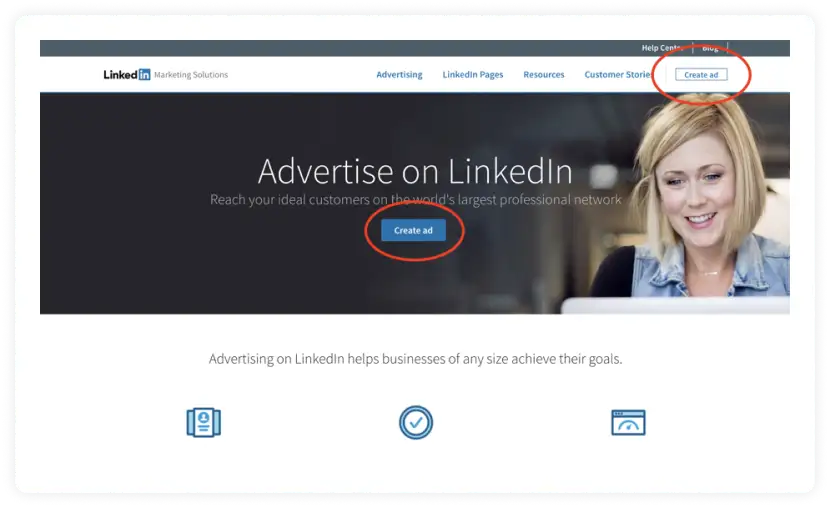
Once you get there, click on one of the 'Create ad' buttons, and the following window will open. Now, click on the 'Create campaign' button.
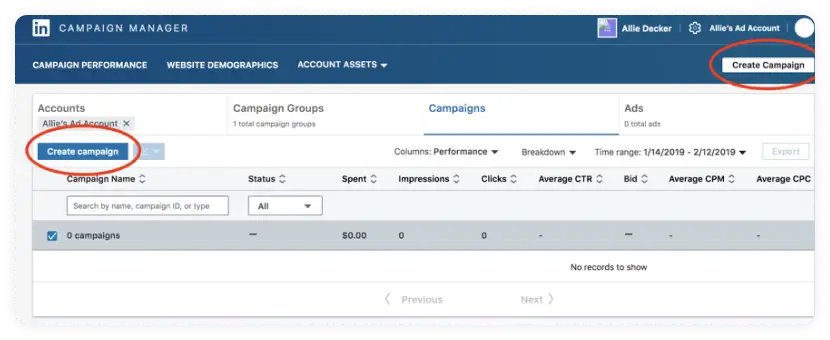
Now, give a group name to your campaign to keep them organized and also give a campaign name to track them without any confusion. (Either of these names won't be visible to your audience)

Step 2: Select your LinkedIn ad objective
Here you need to select the objective of your campaign. The objective should be chosen diligently as various factors, including - ad format, bidding pricing, etc., all depend on the objective.
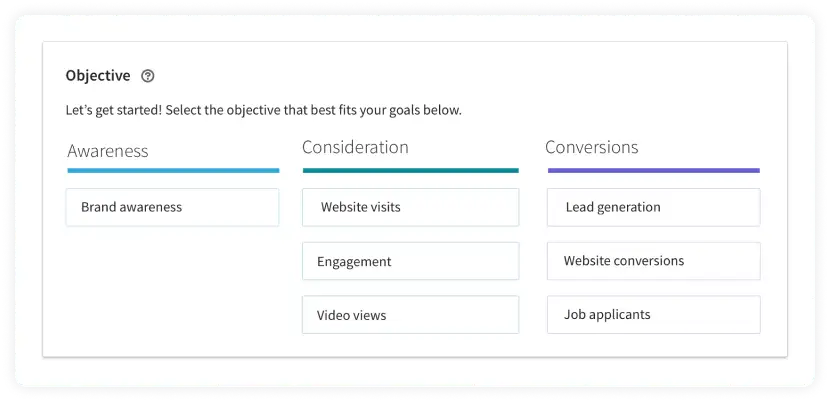
Keep in mind the buyer's journey and the action you want your audience to take when they see your ad. It will help you decide the right objective for your campaign.
Step 3: Choose your target audience
You need to decide the audience to whom you want to show your campaign.
LinkedIn allows you to choose different attributes to target, such as your audience, using attributes job description, education level, interests, or demographics. It's up to you which attribute you want to use.
You can also upload your target audience list using Matched Audiences. This option offers retargeting, email contact retargeting, and account-based retargeting.
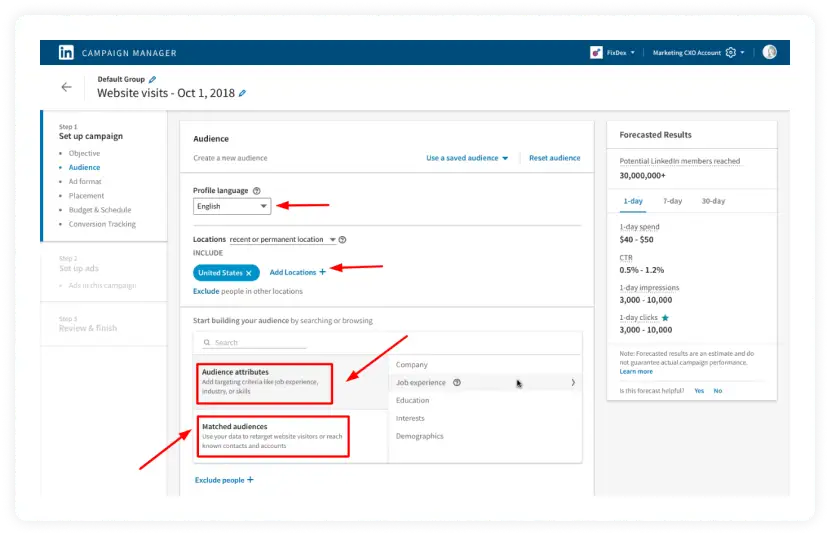
Also read: How to Find Your Target Audience in 2022
Step 4: Select an ad format
Depending upon your objective, you can select from the various ad format option, including:
- Sponsored ads (single image ad, video ad, carousels ad)
- Sponsored messaging(ads in the LinkedIn messaging)
- Text ads (ads on the right trails and the top banner)
- Dynamic ads (tailored ads based on interest, content engagement, etc.)
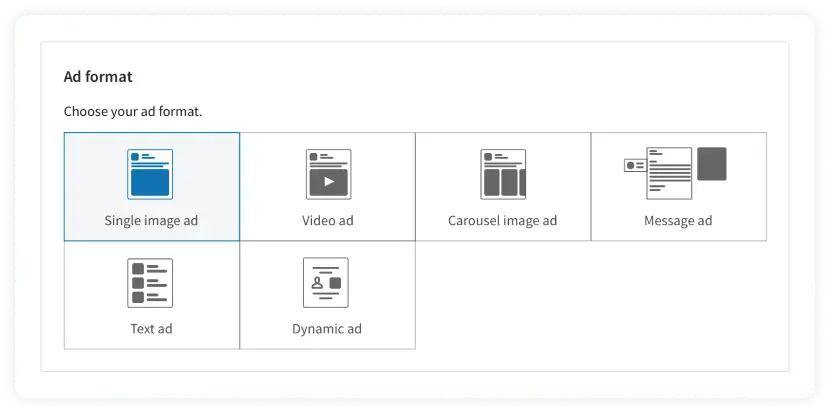
We will discuss each ad format in detail later in this guide.
Step 5: Setup your ad budget and schedule
In this step, you need to set up three things:
Daily budget
Set a daily budget that fits well with your company's marketing spending. Don't invest too much in a single ad campaign. But try to test out variation, see which ad generates the better result, and invest in that more. Such testing will help you save both time and money.
Schedule
Decide a schedule to run your campaign. You can run it day after day or specify an end date.
Bid type: Here, you need to select either of the one options:
- Maximum delivery: It's an automated bid option where LinkedIn determines the amount that fits your budget while getting the best returns on your ads.
- Cost cap: Includes cost per click (CPC), cost per (CPM), cost per lead (CLV), and cost per view (CPV).
- Manual bidding: Advertisers enter the bid amount manually, which is used in the ad auction.

Learn more about LinkedIn's bidding strategy
Step 6: Build your LinkedIn Ad
It's time to create your ad based on your chosen format in step 3. For that, click on the 'create new ad' button.
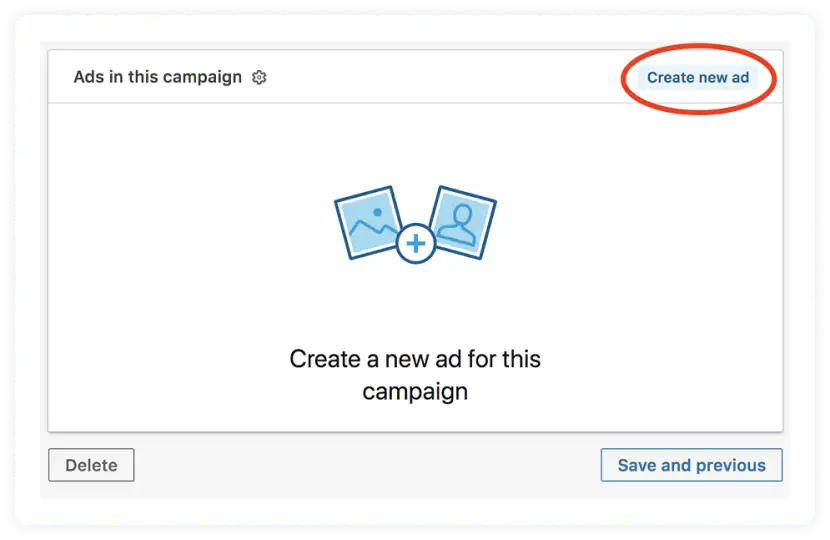
As this ad is what will influence your audience, it needs to be compelling, engaging, and valuable. Here are a few things to keep in mind:
Ad headline: It's the main message of your aid. As per LinkedIn, keep it within 25 characters.
Ad description: it's like a meta description or preview text of your ad. It cannot be more than 75 characters.
Add images: It must be 100x100 pixels and uploaded as a .jpg or .png file that is 2MB or smaller.
URL: Link to a landing page where you want users to land.
Once you create your ad, LinkedIn will show you a preview in your chosen ad format. You can see how it will look in real-time.
Setup conversion tracking (optional)
It's an optional step but can be highly useful for your business. You can track users' actions when they click on your ads by enabling conversions. To enable this option, click '+' conversion.
A new window will pop up. Here, name your conversion, choose conversion settings, and decide how you'll track the conversions.
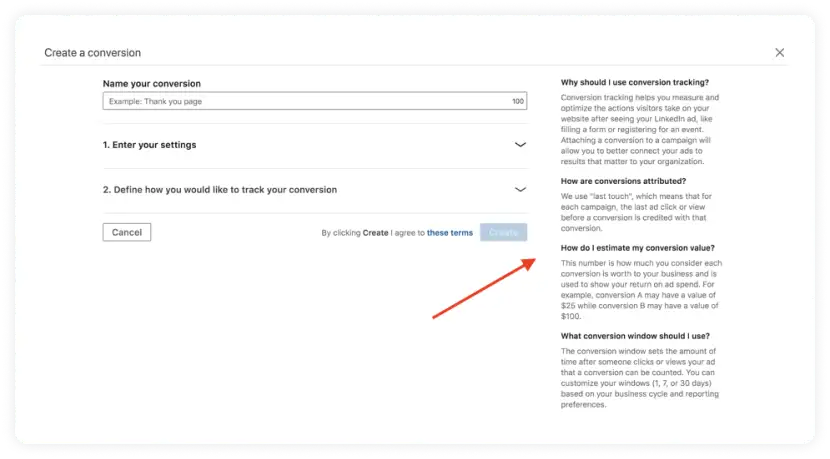
Note: The information on the right side is helpful to help you understand the importance of conversion and how to set it up correctly.
Types of LinkedIn ad format
Sponsored content
Sponsored content ads are displayed in your target audience's news feed and include the following types:
- Single image
- Video ads
- Carousels ads
- Event ads
An example of sponsored LinkedIn event ad content is:
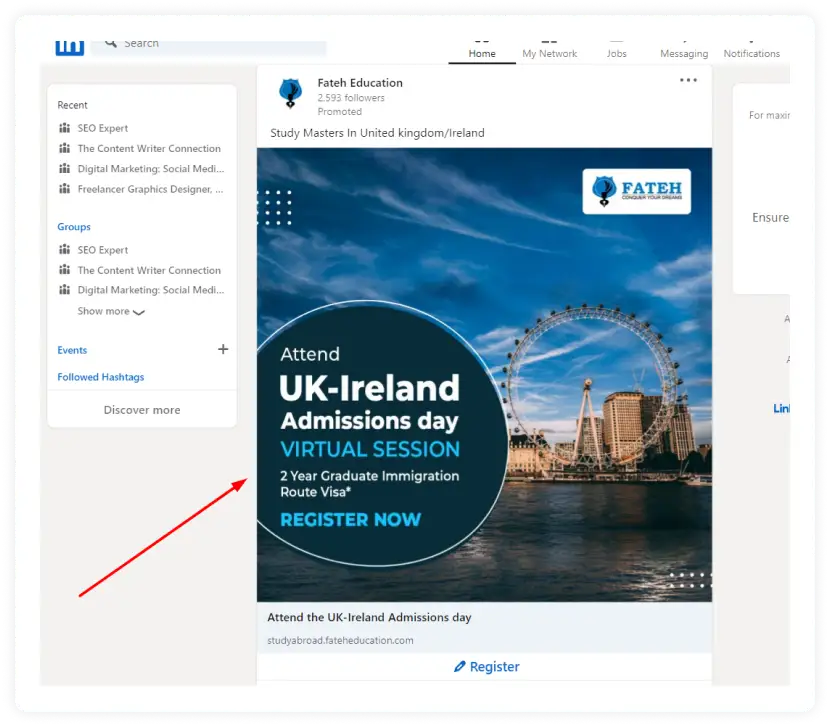
Sponsored messaging
Sponsored messaging involves showing ads to your target audience in LinkedIn messaging, including message ads and conversation ads. Both these ad types are both charged on a cost-per-send/cost-per-displayed basis.
Here's an example of a message and conversation LinkedIn ad:
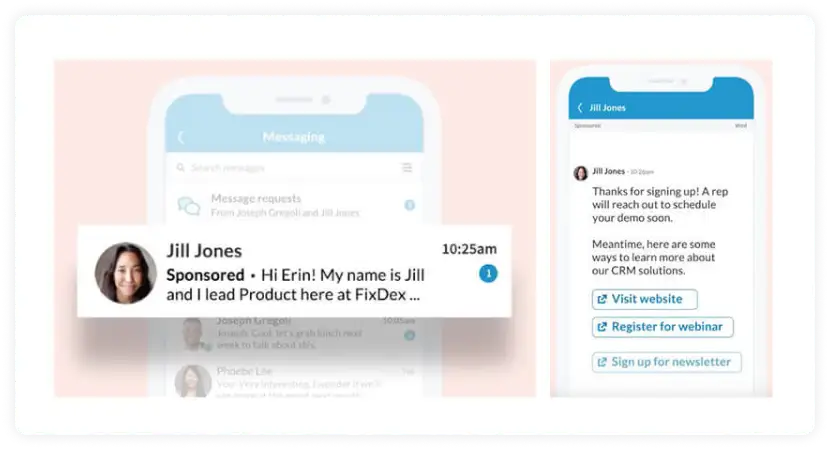
Text ads: Ads on the right side of the news feed
Text ads consist of a headline, brief text, and an image. These ads are placed on the right rail of various LinkedIn desktop pages, including Homepage, profile page, group pages, etc.
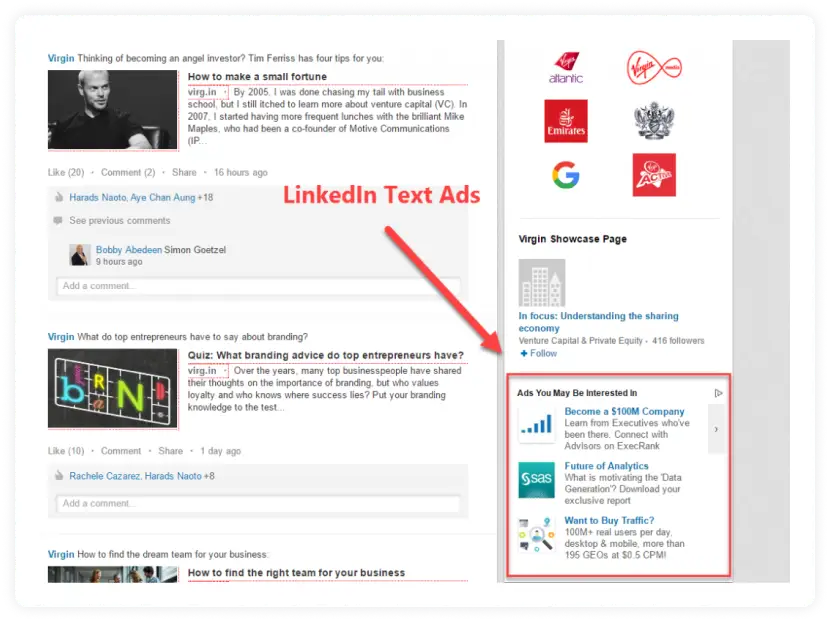
Dynamic ads: Ads personalized to the target audience
As the name suggests, these ads are tailored to individuals based on their interaction, interest, people they follow, and content they engage with.
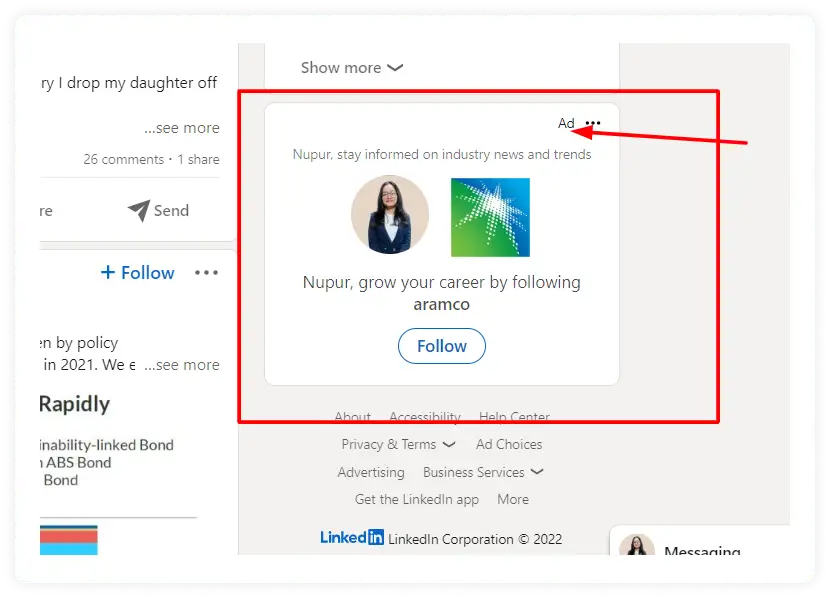
LinkedIn ads best practices
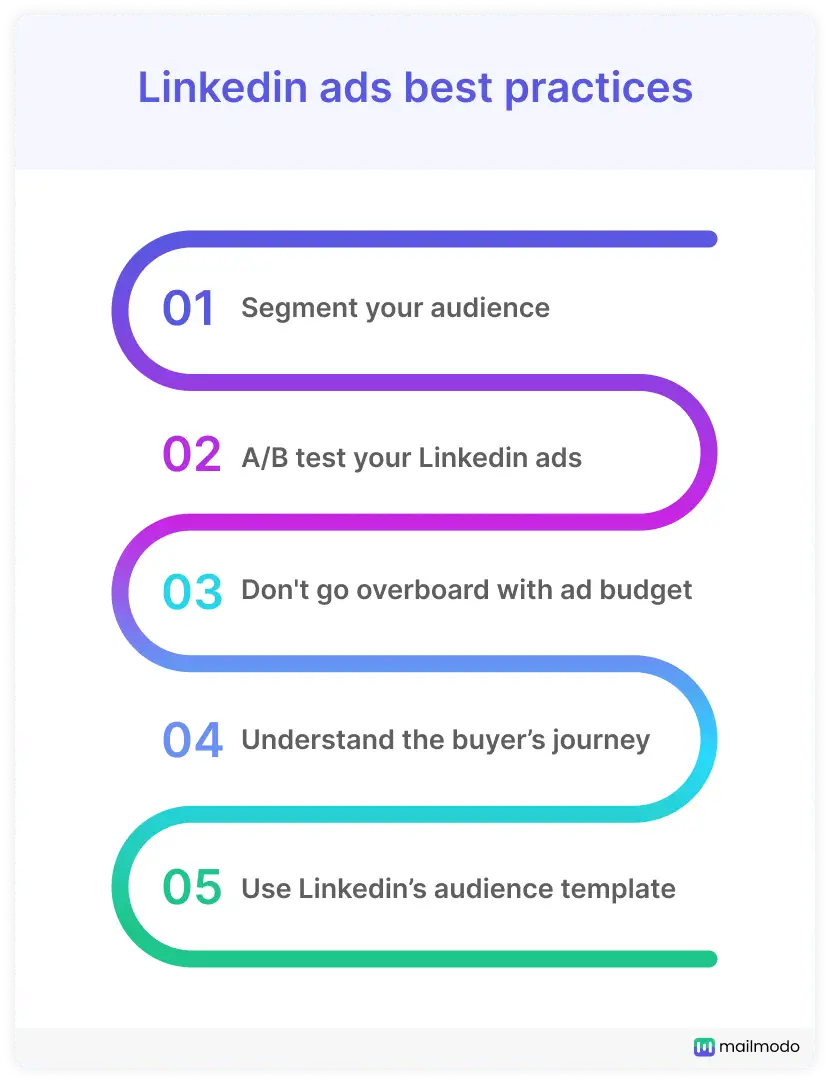
Here are a few best practices to follow to get the highest return on your ads:
• Segment your audience
To get the best return on your LinkedIn ad spends, you must select the right audience segment. You need to analyze your product/services and decide which segment will benefit from your offering.
Some of the criteria you should use include:
Company: Company followers, location, industry, name, and size.
Demographics: Age, gender, and occupation.
Job Profile: Current work position, skills, and year of experience.
Interests: Groups and member interests, people they follow.
Related guide: What Is Audience Segmentation: Benefits & Strategies to Follow
• A/B test your LinkedIn ads
You should test your Linkedin ads by creating two slightly different ad variations. Try changing the headline, visuals, or ad copy and test it out on two different segments of your audience. It will help you analyze which ad performs better, backed up by data.
While testing, avoid testing too many elements together as it will become difficult to assess which change drives the results.
Related guide: A Complete Guide to Perform A/B Testing
• Keep your ad budget in mind
Going over budget to reach more audiences can be tempting, but it might not get you more leads. You need to have a crystal clear understanding of your goals to use your budget efficiently.
• Understand the buyer's journey
As LinkedIn allows you to target audiences in different stages of the buyer's journey, you must analyze the stages users are in.
Showing brand awareness ads to users looking for a solution will waste money. In contrast, users in the awareness stage will not find your demo page valuable as they don't know you yet. So, analyze your audience and meet them where they are in their buyer's journey.
• Use LinkedIn's audience template
IIf you are advertising for the first time, it's advisable to use Linkedin's audience template. These are pre-made templates that provide you with options regarding your target audience. You can choose the audience you think might be relevant to your brand and avoid targeting the wrong users.
What's the cost of advertising on LinkedIn?
The LinkedIn advertising costs are based on your target audience, bidding strategy, objective, and ad relevance score.
• Bidding strategy
LinkedIn offers different bidding strategies, including - Manual, Cost Cap, and Maximum Delivery. You can choose any of them based on your ad campaign goals.
But, just like Google, LinkedIn charges you 0.01$ cent more than the bid price. For instance, if your competitor is willing to pay $3.00 for a click and you are willing to pay $4.00, you will win the auction, and LinkedIn will only charge you $4.01 for the click.
• Ad objective
The ad campaign objective will determine the optimization goals and bidding strategy available to you. Based on these two factors, the pricing strategy of the ad will be determined.
• Target audience
You bid against competitors who are trying to reach a similar audience. In such cases, the pricing varies depending on the desirability of the target audience.
• Ad relevance score
If your ads get engagement, including click-through rate, likes, shares, or comments, LinkedIn will show your ads to more people. But, if your ads are not regenerating engagement, LinkedIn will stop showing the ads. So, a higher ad relevance means a lower price.
So, when you are deciding whether to run ads on LinkedIn or not, you must consider these factors plus your ad budget.
Start advertising today
Now that you are equipped with LinkedIn advertising start creating your first ad, and don't forget to measure its performance. LinkedIn ad campaigns are highly useful in getting both inbound, and outbound leads based on how well you identify your objective and audience. Besides, your ad copy plays a crucial role in getting those clicks.
You can use a customer data platform (CDP)to get a holistic view of your LinkedIn ad performance. CDP offers you a 360-degree view of your audience and helps you create more target campaigns. Do read our guide to understand the ins and out of a CDP.
What you should do next
Hey there, thanks for reading till the end. Here are 3 ways we can help you grow your business:
Talk to an email expert. Need someone to take your email marketing to the next level? Mailmodo’s experts are here for you. Schedule a 30-minute email consultation. Don’t worry, it’s on the house. Book a meet here.
Send emails that bring higher conversions. Mailmodo is an ESP that helps you to create and send app-like interactive emails with forms, carts, calendars, games, and other widgets for higher conversions. Get started for free.
Get smarter with our email resources. Explore all our knowledge base here and learn about email marketing, marketing strategies, best practices, growth hacks, case studies, templates, and more. Access guides here.


